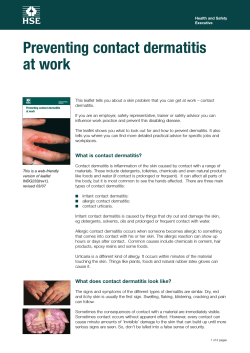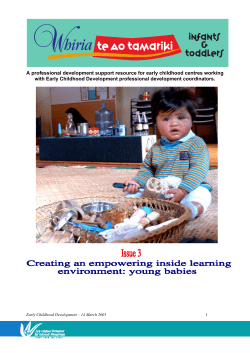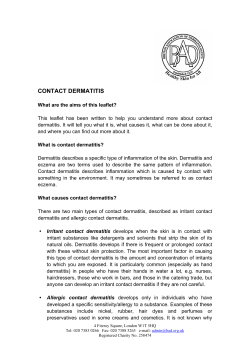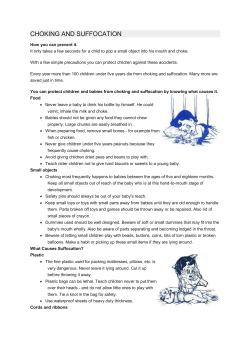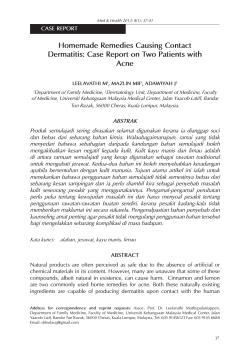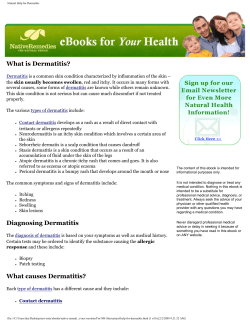
Seborrhoeic Dermatitis in Babies (Cradle Cap)
Page 1 of 2 Seborrhoeic Dermatitis in Babies (Cradle Cap) Seborrhoeic dermatitis in babies causes bad dandruff (cradle cap). It sometimes causes a rash on other areas of the skin. Treatment is not usually needed, as it does not normally cause any discomfort and usually clears on its own. What is seborrhoeic dermatitis? Seborrhoeic dermatitis in babies is a type of skin inflammation which mainly affects the scalp and face. The exact cause of seborrhoeic dermatitis is not known. It is thought that babies who develop this condition may produce more oil (sebum) from the sebaceous glands in their skin. Yeast germs from the Malassezia species may also be involved. However, it is not just a simple skin infection and it is not contagious (you cannot catch this condition from others). The fungal germ lives in the sebum of human skin and some babies may react to the germ in some way which causes the skin inflammation. Many babies have a mild form of this condition within the first six months of life, but it usually goes away on its own after a few months. In most children, it has cleared by the age of 12 months. It does not usually occur in older children. Some teenagers and adults have a related condition which causes bad dandruff and a rash. (See separate leaflet called Seborrhoeic Dermatitis.) What are the symptoms of seborrhoeic dermatitis in babies? Symptoms include: Cradle cap. This is areas of greasy, yellow, scaly patches on the scalp. In some cases a thick scaly layer covers the whole scalp. Over time the scales may become flaky and rub off easily. The condition is not usually itchy and, in most cases, the baby is not aware of any problem or discomfort. Rash. In addition to cradle cap, some affected babies develop a mild red rash. This can appear on the eyebrows, on the skin next to their nose, or in the creases of the skin such as around the neck, behind the ears or in the armpits. Sometimes it can cause a kind of nappy rash in the groin creases. The condition most commonly develops in the first six weeks of life. It tends to last a few weeks or months, and then goes. Page 2 of 2 What is the treatment for seborrhoeic dermatitis in babies? Treatment is not usually needed, as the condition is usually mild, is not serious, and does not usually cause any discomfort to the baby. The condition will usually clear by itself eventually. However, the appearance of the scalp can be improved by daily washing with a baby shampoo followed by gentle brushing with a soft brush to loosen scales. Alternatively, soften the scales with baby oil or warmed olive oil first, followed by gentle brushing, then wash off with baby shampoo. If other areas are affected, regular washing helps. Use an emollient cream instead of soap on the affected skin. If needed, a medicated shampoo or an antifungal cream such as ketoconazole cream may be prescribed by your doctor. This will usually clear the rash. Rarely, if inflammation is more severe, a mild steroid cream may be prescribed by your doctor. Further reading & references O'Connor NR, McLaughlin MR, Ham P; Newborn skin: Part I. Common rashes. Am Fam Physician. 2008 Jan 1;77(1):47-52. Cradle cap (infantile seborrhoeic dermatitis); DermNet NZ Seborrhoeic dermatitis; NICE CKS, February 2013 Sheffield RC, Crawford P, Wright ST, et al; Clinical inquiries. What's the best treatment for cradle cap? J Fam Pract. 2007 Mar;56(3):232-3. Disclaimer: This article is for information only and should not be used for the diagnosis or treatment of medical conditions. EMIS has used all reasonable care in compiling the information but make no warranty as to its accuracy. Consult a doctor or other health care professional for diagnosis and treatment of medical conditions. For details see our conditions. Original Author: Dr Tim Kenny Current Version: Dr Mary Harding Peer Reviewer: Dr Helen Huins Last Checked: 09/09/2013 Document ID: 4828 Version: 40 © EMIS View this article online at www.patient.co.uk/health/seborrhoeic-dermatitis-in-babies-cradle-cap. Discuss Seborrhoeic Dermatitis in Babies (Cradle Cap) and find more trusted resources at www.patient.co.uk. EMIS is a trading name of Egton Medical Information Systems Limited.
© Copyright 2025











